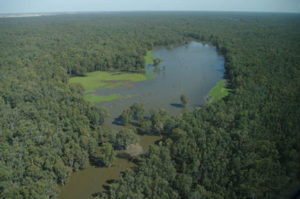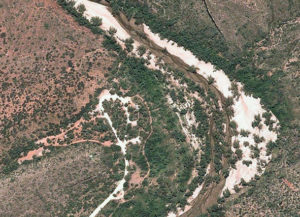Floodplains and Wetlands
This case study is from the Murray-Darling Basin, Australia. It was designed to show how adaptation services can be identified and managed for under transformational climate change. We followed a simple four-step process: (1) describing the system in its current state; (2) predicting biophysical responses to climate change; (3) identifying adaptation services under climate change and (4) detailing requirements for the management of adaptation services.
Large reductions in river flows are likely under a scenario of +1.6°C by 2030, even with additional water restored to rivers. We predict major changes to floodplain ecosystems. These changes include the contraction of flood-dependent forests and woodlands and the expansion of terrestrial, drought-tolerant vegetation communities.

Hut Lake, Barmah Forest, River Murray, southern Australia (photo copyright Keith Ward)
Examples of adaptation services under this scenario include (1) substitution of irrigated agriculture with dryland cropping and floodplain grazing; (2) mitigation of damage from rarer, extreme floods; and (3)increased tourism, recreational and cultural values derived from fewer, smaller wetlands that can be maintained with environmental flows.
Management for adaptation services will require decisions on where intervention can enable ecosystem persistence and where transformation is inevitable. New approaches to managing water under climate change will require consideration of how to manage for adaptation services. Such approaches will involve changes to decision-making in order to account for landscape heterogeneity and change.

Riparian river red gums on arid floodplains provide vital refugia for biodiversity and important adaptation services such as regulation of microclimate and water flows
For more information:
Kahan G, Colloff MJ, Pittock J (2020, published online) Using an ecosystem services approach to re-frame the management of flow constraints in a major regulated river basin. Australasian Journal of Water Resources https://doi.org/10.1080/13241583.2020.1832723
Colloff, M.J., Pittock, J. (2019) Why we disagree about the Murray-Darling Basin Plan: environmental knowledge and the science-policy decision context. Australasian Journal of Water Resources 23, 88–98. https://doi.org/10.1080/13241583.2019.1664878
Abel, N., Wise, R.M., Colloff, M.J., Walker, B.H., Butler, J.R.A., Ryan, P., Norman, C., Langston, A., Anderies, J.M., Gorddard, R., Dunlop, M. and O’Connell, D. (2016) Building a resilient pathway towards transformation when “no-one is in charge”: insights from Australia’s Murray-Darling Basin. Ecology and Society 21(2), 23. [online] http://dx.doi.org/10.5751/ES-08422-210223
Colloff, M.J., Lavorel, S., Wise, R.M., Dunlop, M., Overton, I.C. and Williams, K.J. (2016) Adaptation services of floodplains and wetlands under transformational climate change. Ecological Applications 26, 1003-1017. http://dx.doi.org/10.1890/15-0848
